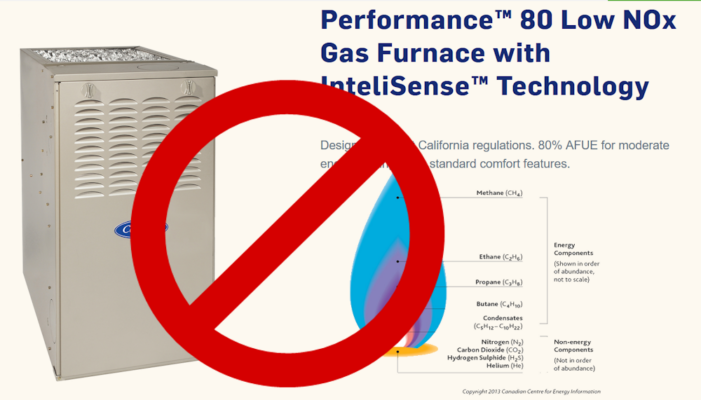Why Don’t We Use Natural Gas In Passive House?

I’ve mentioned a few times that we’re building a passive house (fence just went up, Yay!). One of the “different” things about passive house is that everything is electric – everything. In a recent discussion around HVAC in passive houses, I mentioned that using natural gas (NG) would be a really bad idea. The other person asked, why. Having spent the time to explain it, I figured it might be useful to share that more broadly.
When we burn NG perfectly, it creates NO2, CO2, and water (and a bunch of other junk). When we burn it imperfectly, which is most of the time, it also creates CO (how much pivots around how imperfect). CO is potentially deadly. This is why we put CO (and smoke) detectors in rooms where we burn NG. NO2 isn’t awesome either, it impacts respiratory health both in the short and long term. If you’re curious about digging into this topic more, there are myriad studies and news articles on the topic. The TL;DR is that NG itself, and burning NG, is not great for you.
If you want to measure this yourself. Put an air quality (AQ) sensor next to a gas stove. Even with an exhaust fan going, you will see the AQ deteriorate to undesirable levels. This is why it is important to have an fan that exhausts to the outside, run the fan when cooking, and run it for a period afterwards. We will be using induction cook tops in our build. Induction won’t completely solve this problem, cooking is a more complicated topic, not going to get into that now, probably in another post.
Why we use NG in many homes is very much a trade-off thing. Burning things isn’t great for us, or the environment, but freezing to death (or even being cold) is inconvenient. So we deal (cough, ignore) with the long term health issues.
In a typical modern house you get several air changes an hour because they aren’t sealed well. IIRC, the average number is ~6. In an older house, the number is significantly higher. In some cases twice or more.
In a passive house, the number of air exchanges is very low. IIRC, Passivhaus is 0.6. PHIUS has a couple different standards, IIRC Zero is 0.5. I recently witnessed a blower test where they hit 0.36.
When you’re doing 6-12 air changes an hour, the level of inconvenience from burning NG in our homes is a tolerable (while still undesirable) trade-off. It’s unlikely to kill you. It’s unlikely that you will experience any short-term respiratory issues unless you are prone to these conditions. Even in a properly functioning furnace, there will always be some of the exhaust containing the unwanted combustion bi-products mixed into the forced air heat as it goes through the air handler. If you’ve ever examined a furnace while it’s operating, you can see how that happens.
It does occasionally kill people. CO detectors malfunction, something partially blocks the exhaust, or there isn’t enough O2 in the room during combustion, awful. But, for the most part, it’s a trade-off that makes sense. NG is cheap, we like cheap, we don’t want to freeze. The health consequences are mostly long term and/or isolated to a subset of the population.
In a tightly sealed house, the math is very different. We can’t count on the NO2/CO2/CO leaking out in the 6-12 air changes per hour. It can build to dangerous levels quickly. This problem isn’t isolated to combustion. The off-gassing from objects, animals, and people in the house is also a healthy air issue in these buildings. This is why specialized air exchange elements in the HVAC (part of conditioning is quality control) are critical. The primary goal is keeping the AQ in the building healthy, but we don’t want to ignore efficiency. This is where we need to bring ERV and HRV into the discussion.
An ERV (Energy Recovery Ventilators) allows us to recover some of the energy expended in temperature and humidity conditioning (both up and down).
HRV (Heat Recovery Ventilators) only allows us to recover some of the energy expended on temperature.
So ERV are essentially HRV+.
It’s important to understand a few things:
- HRV/ERV are not 100% efficient
- ERV do not manage humidity, they conserve humidity levels in the house
- Humidifiers and dehumidifiers are how we manage humidity levels
If you are using a humidifier to raise the humidity in your home, an ERV will capture some of that humidity when it exchanges air with the outside. Reducing the demand on the humidifier. If you are using a dehumidifier to lower the humidity in your home, an ERV will make the incoming air dryer. Reducing the demand on the dehumidifier.
There isn’t a 100% right answer between ERV and HRV. But in general, if you live in a climate where managing humidity is desirable, ERV is going to be the better functional choice; it’s HRV+ after all.
There is some complexity when including cost into the equation; ERV usually cost more. If you live in a climate where you don’t need to aggressively manage humidity, it might not be worth the cost to build a system that manages humidity more efficiently. If you live in a climate where managing humidity is important, the opposite is likely true.

Insightful read! Great explanation on energy efficiency and sustainability. Loved how clearly you addressed natural gas in passive house design.
Really interesting breakdown of why natural gas isn’t ideal for passive houses. Indoor air quality is such an underrated factor when people think about “green” or “efficient” living. I’ve been looking into smarter monitoring and remote systems lately, and tools like GCMOB make it easier to keep track of security and home management from anywhere. Combining all-electric design with better tech monitoring feels like the way forward.